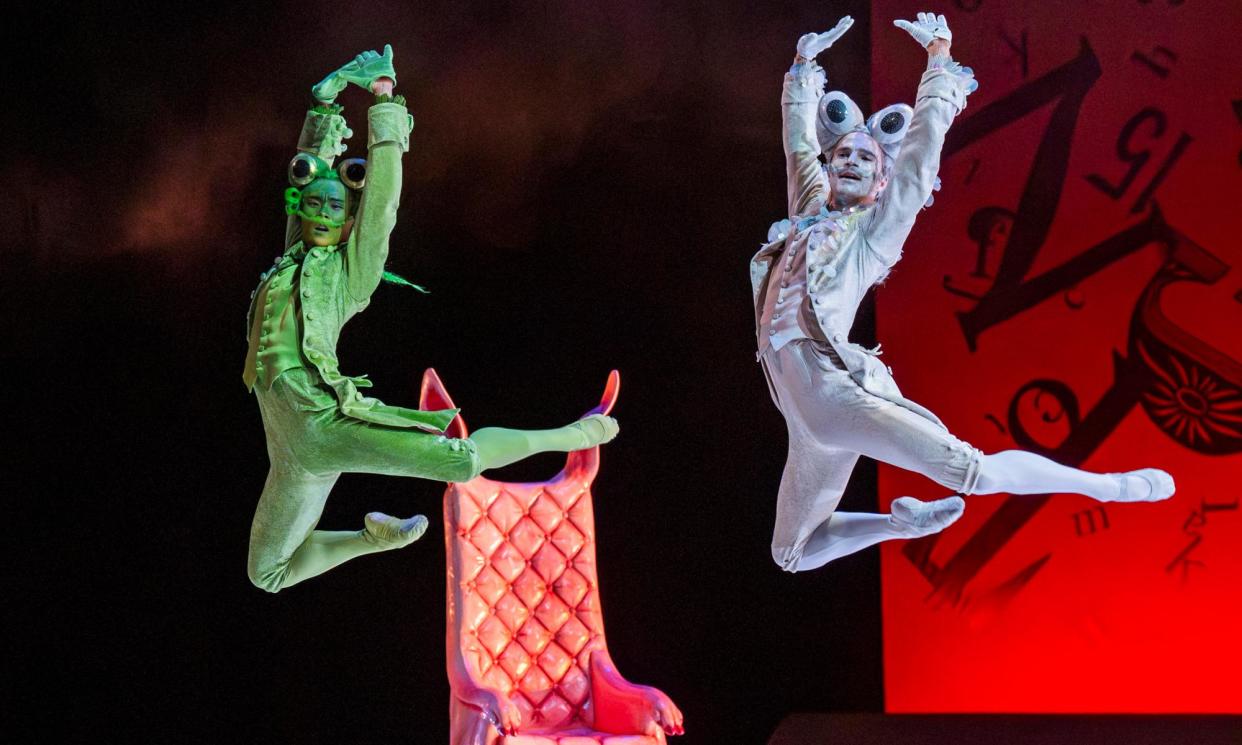Alice’s Adventures in Wonderland; Frontiers: Choreographers of Canada review – dreamscapes and new realities

It’s 13 years since Christopher Wheeldon’s Alice’s Adventures in Wonderland first tiptoed across the stage of the Royal Ballet before tumbling down a rabbit hole. In that time, this retelling of Lewis Carroll’s episodic adventure story, a cross between a hallucinogenic dream and a gentle coming-of-age narrative, has become a favourite across the world.
In part that’s thanks to Bob Crowley’s inventive designs, full of strong colour, using every trick in the visual book from projections to puppets to lavish costume. But it’s also due to Wheeldon’s ability to blend demanding classical dance steps with comedy and Broadway razzle dazzle.
It’s hard to resist a ballet where the Caterpillar is depicted by a chorus line of blue-spangled legs, and the Queen of Hearts dances a manic Tart Adage (in direct tribute to the famous Rose Adagio in The Sleeping Beauty) with four terrified suitors sticking jam tarts in their open mouths and ducking her pointed feet as she approaches with menace.
Each character, from bouncing footmen to floating Cheshire Cat, has a distinctive flavour and purpose, all emphasised by Joby Talbot’s richly textured score. It’s a dream for a big company and you can feel the Royal Ballet’s dancers stretching into its different shades with pleasure as they begin a long run in the repertory.
At the matinee performance I saw, first artist Viola Pantuso made a charming debut as Alice, full of wide-eyed excitement; Marcelino Sambé, as her nascent love interest Jack, partnered with tender care and exhilarating joy. In the evening, Francesca Hayward and William Bracewell were utterly lovely, their relationship flecked with warmth and growing delight, their dancing easy, expansive and musical.
Lauren Cuthbertson, the first Alice, graduated to the Queen of Hearts with aplomb, exhibiting a steely technique and venomously precise comic timing. Steven McRae returned from long injury to dazzle as the tap-dancing Mad Hatter.
Returning to the UK for the first time since 2013, The National Ballet of Canada has brought Frontiers, a chamber bill of ballets by Canadian choreographers, culminating in the UK premiere of Crystal Pite’s astounding Angels’ Atlas, another work where design is utterly crucial to effect. Designer Jay Gower Taylor and lighting designer Tom Visser create a wall of reflected white light, constantly shifting and changing, sometimes looking like the trails of fireworks, sometimes like cracking ice. In front of it, the dancers move in large scale groupings, or spin and fall in pairs.
The movement is constantly surprising – great swirls of turns, patterns of hearts beating, bodies rising and falling as breath seems to be passed from one dancer to the next in a graceful canon. The theme is fragility and endurance and, underpinned by a keening score of Tchaikovsky and Morten Lauridsen, it is overwhelmingly moving.
The two other works make less impact. Passion by James Kudelka, sets a contemporary couple amid the formalities of traditionally romantic classical dancing, while Islands, by rising star Emma Portner, is a thoughtful examination of dependency and separation, explored by attaching two dancers together and then setting them apart. All are danced with commitment, by a company it is a pleasure to watch.
Star ratings (out of five)
Alice’s Adventures in Wonderland ★★★★
Frontiers: Choreographers of Canada ★★★
• Alice’s Adventures in Wonderland is at Royal Ballet and Opera until 1 November and from 13 June-6 July 2025
• Frontiers: Choreographers of Canada is at Sadler’s Wells, London until 6 October


